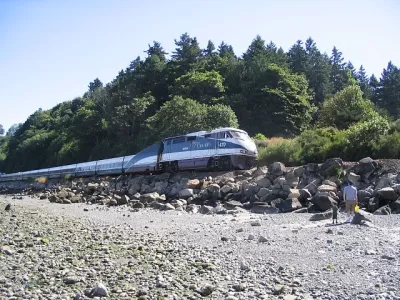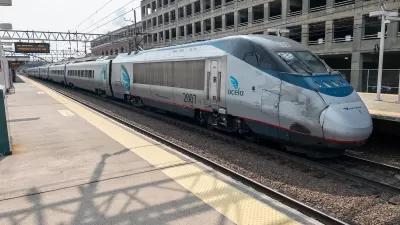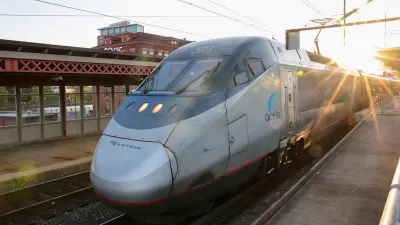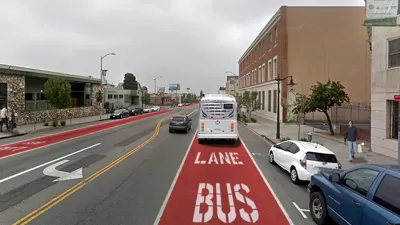Language in the new infrastructure bill calls for the agency to prioritize ridership and service levels over profitability.

"2021 will be a defining moment for the future of passenger rail in America," writes Jake Blumgart. "Amtrak faces huge challenges, but the systemic changes to travel and work life wrought by the pandemic also present an opportunity to fundamentally rethink how the agency operates." Meanwhile, the new infrastructure bill "could allow Amtrak’s executives to make paradigm-shifting operational changes — placing ridership over revenues and faster speeds over minimizing costs."
"In a country where transportation is the largest source of greenhouse emissions, there is no cleaner way to travel than by train." But the business travel that was the lifeblood of Amtrak's Northeast Corridor services "remains severely constrained," and prohibitively expensive fares lead travelers to choose driving instead. Outside of the Northeast Corridor, it isn't the cost but rather "the infrequency and unreliability of the trains that makes Amtrak uncompetitive."
Part of the problem, says Blumgart, is Amtrak's history: "the legislation creating Amtrak specifies that it should be operated and managed as a for-profit service, something that no other country’s rail network requires or accomplishes." According to Amtrak public relations manager Kimberly Woods, "[b]ecause Amtrak is operated as a for-profit company and is required by law to maximize revenues, its fares vary based upon demand, like airlines and intercity buses." The revised mandate proposed in the infrastructure bill "would get rid of the Nixon-era language about minimizing subsidies and instead refocus the agency’s mission on expanding passenger rail capacity and adding ridership," giving it more flexibility to experiment with fare structures. "Just as owners of office buildings and commuter rail lines are being forced to grapple with a new reality, perhaps changes to ridership wrought by the pandemic will force policymakers to change."
FULL STORY: Will Amtrak Make Fares Cheaper as Business Travel Drops?

Study: Maui’s Plan to Convert Vacation Rentals to Long-Term Housing Could Cause Nearly $1 Billion Economic Loss
The plan would reduce visitor accommodation by 25,% resulting in 1,900 jobs lost.

North Texas Transit Leaders Tout Benefits of TOD for Growing Region
At a summit focused on transit-oriented development, policymakers discussed how North Texas’ expanded light rail system can serve as a tool for economic growth.

Why Should We Subsidize Public Transportation?
Many public transit agencies face financial stress due to rising costs, declining fare revenue, and declining subsidies. Transit advocates must provide a strong business case for increasing public transit funding.

How to Make US Trains Faster
Changes to boarding platforms and a switch to electric trains could improve U.S. passenger rail service without the added cost of high-speed rail.

Columbia’s Revitalized ‘Loop’ Is a Hub for Local Entrepreneurs
A focus on small businesses is helping a commercial corridor in Columbia, Missouri thrive.

Invasive Insect Threatens Minnesota’s Ash Forests
The Emerald Ash Borer is a rapidly spreading invasive pest threatening Minnesota’s ash trees, and homeowners are encouraged to plant diverse replacement species, avoid moving ash firewood, and monitor for signs of infestation.
Urban Design for Planners 1: Software Tools
This six-course series explores essential urban design concepts using open source software and equips planners with the tools they need to participate fully in the urban design process.
Planning for Universal Design
Learn the tools for implementing Universal Design in planning regulations.
Ascent Environmental
Borough of Carlisle
Institute for Housing and Urban Development Studies (IHS)
City of Grandview
Harvard GSD Executive Education
Toledo-Lucas County Plan Commissions
Salt Lake City
NYU Wagner Graduate School of Public Service





























